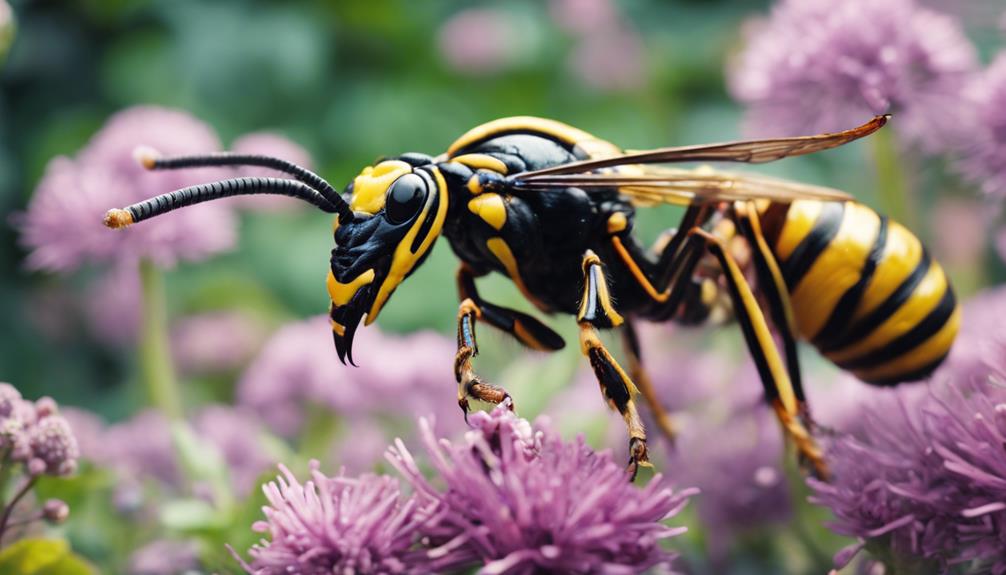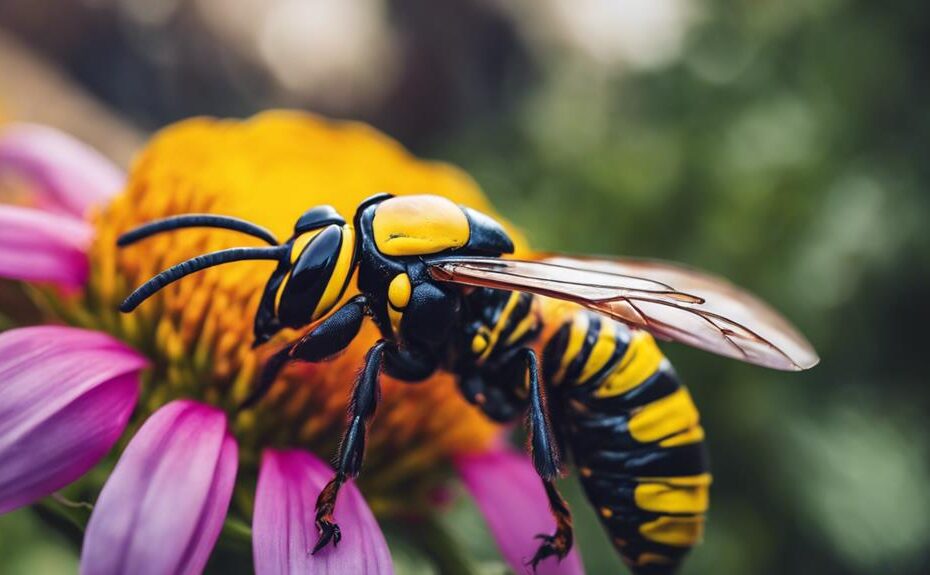The mammoth wasp, scientifically known as Megascolia maculata, is a remarkable insect that commands attention due to its impressive size and striking appearance. Found in various regions across Europe, Asia, and Africa, this species exhibits intriguing nesting behaviors and feeding habits that set it apart from other wasp species.
Additionally, its reproductive strategy and predatory skills add layers to its already fascinating nature. The interactions between mammoth wasps and humans reveal surprising insights into the delicate balance of nature. These aspects, when considered collectively, paint a captivating picture of this enigmatic creature.
Size and Appearance
The Mammoth Wasp, scientifically known as Megascolia maculata, is a striking insect that boasts an impressive size and distinct appearance. These giant insects can reach lengths of up to 6 centimeters, making them one of the largest wasp species in the world. Their bodies are predominantly black, with striking yellow bands across their abdomen, giving them a visually captivating look. The contrast between their dark bodies and bright yellow markings serves as a warning signal to predators about their potent sting.
In addition to their size, Mammoth Wasps have unique physical features that set them apart from other insects. Their wings are translucent and veined, allowing them to soar gracefully through the air in search of food and mates. The females of this species are larger than the males, further emphasizing their imposing presence in their natural habitat. Overall, the Mammoth Wasp's size and striking colors make it a fascinating subject of study for entomologists and nature enthusiasts alike.
Habitat and Distribution
The habitat and distribution of the mammoth wasp are intriguing subjects to explore. Understanding the range and territories where these wasps reside, their preferred nesting locations, and the environmental adaptations they exhibit can provide valuable insights into their ecological niche.
Delving into these aspects can shed light on the survival strategies of this fascinating insect species.
Range and Territories
Naturally found in various regions across Europe, Asia, and North Africa, the Mammoth Wasp demonstrates a wide distribution range in its habitat.
These wasps exhibit fascinating behavior patterns, showing intricate population dynamics within their territories. They are known to have specific migration routes to follow during seasonal movements, indicating a deep-rooted instinctual behavior.
Breeding grounds play a crucial role in their population maintenance, with the wasps meticulously selecting suitable locations for reproduction.
The Mammoth Wasp's ability to thrive in diverse environments across continents showcases its adaptability and resilience. Understanding their range and territories contributes to appreciating the intricate ecological interactions these impressive insects engage in.
Preferred Nesting Locations
Demonstrating a remarkable preference for specific nesting locations, the Mammoth Wasp strategically selects habitats that offer ideal conditions for reproduction and survival. These locations include:
- Underground burrows: Mammoth Wasps show a distinct inclination towards nesting in underground burrows, which provide protection from predators and extreme weather conditions.
- Tree hollows: The Mammoth Wasp also displays a preference for nesting in tree hollows, utilizing the natural crevices and spaces within trees to establish their nests.
- Optimal conditions: Both underground burrows and tree hollows offer the Mammoth Wasp the necessary shelter, security, and insulation essential for the successful development of their offspring.
Environmental Adaptations
Adapted to diverse environments, the Mammoth Wasp exhibits remarkable flexibility in its habitat selection and distribution patterns. This adaptability is essential for its survival mechanisms and is attributed to evolutionary traits that have shaped its behavioral adaptations. The Mammoth Wasp occupies a unique ecological niche, utilizing various habitats across its distribution range. Below is a table illustrating the diverse habitats where the Mammoth Wasp can be found:
| Habitat Type | Distribution |
|---|---|
| Forests | Europe, Asia |
| Grasslands | Africa, Australia |
| Meadows | North America |
| Gardens | South America |
| Wetlands | Southeast Asia |
Nesting Behavior
The nesting behavior of the Mammoth Wasp involves a meticulously orchestrated process that showcases their remarkable instincts and adaptations. These wasps exhibit intriguing social behavior and employ sophisticated communication methods during the nesting phase.
Nesting Behavior of the Mammoth Wasp:
- Solitary Nesting: Unlike some other wasp species, Mammoth Wasps are solitary nesters. Each female excavates her own burrow in the ground to build individual nests, showcasing independence in their nesting behavior.
- Prey Provisioning: After constructing the nest, the female Mammoth Wasp hunts down a variety of prey, typically grasshoppers or crickets, to provision the nest cells. This ensures that the developing larvae have an adequate food supply once they hatch.
- Egg Laying and Nest Sealing: Once the nest cells are provisioned, the female lays a single egg in each cell before sealing it off. This meticulous process of egg-laying and nest sealing is crucial for the offspring's survival and development.
Feeding Habits

With a diverse diet that includes nectar, pollen, and sometimes even the fluids of plants, the Mammoth Wasp's feeding habits play a vital role in sustaining its energy and reproductive capabilities. Mammoth Wasps exhibit interesting foraging behavior, actively seeking out sources of nectar and pollen to meet their nutritional needs. Their dietary preferences are not limited to just one type of food, allowing them to adapt to different environments and food availability.
| Foraging Behavior | Dietary Preferences |
|---|---|
| Mammoth Wasps are efficient foragers, often visiting a variety of flowers in search of nectar. | Nectar: Rich in sugars, nectar provides energy for the wasps. |
| They also collect pollen, which is a crucial protein source for developing larvae. | Pollen: High in proteins, essential for larval development. |
| Mammoth Wasps have been observed feeding on plant fluids, possibly for additional nutrients. | Plant Fluids: Supplemental nutrients for overall health. |
| Their foraging behavior is essential for pollination, benefiting the ecosystem. | Diverse Diet: Allows for adaptability to different food sources. |
| Mammoth Wasps play a significant role in maintaining plant diversity through their feeding habits. |
Reproductive Strategy
Mammoth Wasps employ a sophisticated reproductive strategy characterized by intricate mating rituals and specialized nesting behaviors to ensure the successful propagation of their species. These wasps exhibit remarkable behaviors related to mating and reproduction, ensuring the survival of their offspring through meticulous care and protection.
Reproductive Strategy of Mammoth Wasps:
- Mating Rituals and Brood Care:
- Male mammoth wasps engage in elaborate mating rituals to attract females for successful copulation. After mating, females take on the responsibility of finding suitable nesting sites and providing care for their brood. The female meticulously selects a location, constructs a nest, and lays eggs within individual cells, each provisioned with paralyzed insects to serve as food for the developing larvae.
- Oviposition and Larval Development:
- The female mammoth wasp practices oviposition by depositing eggs into the provisioned cells. Once the eggs hatch, the larvae feed on the paralyzed insects, undergoing several stages of development before pupating. The mother wasp vigilantly guards the nest and continues to provide protection and nourishment until the larvae mature into adult wasps.
Predatory Skills

Exhibiting exceptional predatory prowess, Mammoth Wasps showcase a formidable set of skills honed through evolution to efficiently hunt and subdue their prey. These wasps are adept predators, engaging in intricate predator-prey dynamics to secure their meals. Their hunting techniques are both fascinating and efficient, allowing them to successfully capture various prey items. Below is a table highlighting some of the impressive predatory skills of the Mammoth Wasp:
| Predatory Skills of the Mammoth Wasp | Description | Example |
|---|---|---|
| Sting immobilization | Uses powerful sting to paralyze prey | Stinging a large caterpillar |
| Burrowing to locate prey | Digs into the ground to find hidden prey | Unearthing beetle larvae |
| Carrying prey back to nest | Drags prey to nest for consumption | Transporting a paralyzed spider |
These hunting strategies demonstrate the Mammoth Wasp's adaptability and efficiency in capturing prey, showcasing their essential role in maintaining ecological balance through predator-prey interactions.
Interactions With Humans
Interacting with humans, the presence of Mammoth Wasps can sometimes lead to intriguing encounters that offer valuable insights into the dynamics between these fascinating insects and human activities. These interactions have been the subject of various behavior studies, shedding light on how Mammoth Wasps navigate their surroundings when humans are involved.
Here are three key points to consider:
- Feeding Behavior: Observations have shown that Mammoth Wasps, despite their intimidating size, are generally non-aggressive towards humans unless provoked. They primarily focus on hunting prey such as beetles and caterpillars, rather than seeking out human interaction.
- Nesting Sites: Human-made structures, like sheds or barns, can inadvertently become nesting sites for Mammoth Wasps. Understanding their preference for certain locations can help humans coexist peacefully with these insects without causing disturbance to their colonies.
- Educational Opportunities: Interactions with Mammoth Wasps present unique educational opportunities for researchers and the public alike. Studying their behavior in response to human presence can provide valuable insights into the adaptability and resilience of these creatures in changing environments.
Frequently Asked Questions
How Do Mammoth Wasps Communicate With Each Other?
Mammoth wasps communicate through intricate nesting behavior and chemical signals. They rely on pheromones to convey messages about location, food sources, and potential threats. This sophisticated system allows for efficient coordination and cooperation within the colony.
Are Mammoth Wasps Social Insects or Solitary Insects?
"Unity is strength." Mammoth wasps exhibit solitary behavior, with females constructing individual nests to lay eggs and provision them with paralyzed prey. Unlike social insects, such as bees or ants, mammoth wasps do not form colonies or engage in cooperative behaviors.
Do Mammoth Wasps Have Any Predators Besides Humans?
Predator-prey relationships are crucial for maintaining ecological balance. Besides humans, mammoth wasps may face predators such as birds, spiders, and parasitic wasps. These interactions contribute to the complex web of life in their ecosystem.
How Long Do Mammoth Wasps Typically Live?
In the intricate tapestry of nature, the mammoth wasp typically lives an average lifespan of 1 year. Their reproductive cycle is a vital aspect of their existence, with females laying eggs in carefully chosen locations to ensure survival.
Are Mammoth Wasps Considered Beneficial to the Environment in Any Way?
Mammoth wasps are beneficial to the environment as they contribute to pollination by feeding on nectar and transferring pollen. Additionally, they aid in pest control by preying on insects that can harm crops, making them valuable allies in ecosystem balance.
Conclusion
In conclusion, the mammoth wasp is a fascinating and formidable insect known for its impressive size, predatory skills, and unique reproductive strategy.
Despite its intimidating appearance, this species plays a crucial role in its ecosystem by controlling populations of other insects.
Its nesting behavior and feeding habits are intricately linked to its survival and success in the wild.
Overall, the mammoth wasp is a remarkable creature with many intriguing characteristics that warrant further study.

